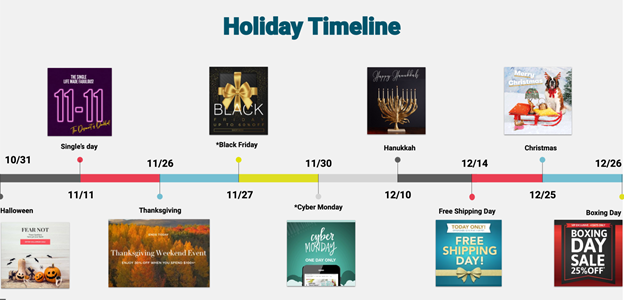SPONSOR CONTENT FROM CHEETAH DIGITAL
Don’t Be a Marketing Grinch: 5 Tips for Creating Your Best Holiday Emails Ever
We wasted many hours while crafting this guide to figure out whether we could appropriately crowbar Alanis Morissette’s “Ironic” into the introduction:
“It’s the holiday email created in the heart of summer,
It’s like planning for Christmas in July,
And who would’ve thought it figuuuuuured”
That just sounds like something that should be there right? But are these things ironic? Not really, but we won’t let grammatical pedantry get in the way of that one idea we couldn’t shake. Here we are — it’s July and while most of the population are working on their tans, we marketers know that it’s the perfect time to think ahead to our Christmas campaigns.
That’s right, it’s time to shift our thinking to the days growing ever shorter, the leaves beginning to brown and pumpkin-spiced everything hitting our shelves; it is one of the busiest times of the year for the beloved brand marketers we work with. But rather than leave everything to one night like Ol’ Saint Nick, proactive marketers will be relaxing with a glass of eggnog and roasting their chestnuts on an open fire — as the painstaking planning of content, offers, and crafting messages was done in t-shirt weather. That’s why we have released this guide in the heart of summer. We know you’re busy planning for the end of the year before the days have even begun to get shorter.

We’ve created a helpful guide for marketers this year, called the Ultimate Holiday Campaign Planning Resource for Digital Marketers. Today, we’ll give you a sneak peek of one of the sections, Wrapping Content in the Right Messaging, where we’ll share the top five ways you can make your holiday emails better.
Wrapping Content in the Right Messaging
Read any thought
leadership blog on better email marketing and you’ll no doubt get into the optimization rabbit hole. How many characters constitute the perfect subject line length? How many calls-to-action
generate the best click-through rates? What’s better, a pre-work or post-work send time…or maybe even weekends? And what are the pros and cons of including images? All of these things are
important of course, but what really moves the needle, consider the following;

What does it mean for you? You don’t have to send all your campaigns in the evening hours, but consider peak engagement times for the messages that you really want to get delivered.
2. A sense of urgency can work against you. Oft-quoted advice in email campaigns is to use a sense of urgency in the subject to get more clicks. Unfortunately, this advice seems to have been used so much that customers are ignoring these emails altogether: subject lines that stress urgent actions underperformed by 1.5% in terms of open rate.What does it mean for you? Urgency still has its place, especially when it comes to approaching expiration dates for coupons or items that actually need timely attention. But for your holiday messages, you should avoid the overuse of urgency-related expressions as they don’t necessarily help with performance.
3. Incorporate animation to make things exciting. The holidays are full of lively and spirited times, so it makes sense that customers seem especially receptive to emails that include something a little more eye-catching. Case in point: animation. We found that the use of animation in email content increased click rates by 2.2% but our model found no statistically significant contribution on expected transaction rates.What
does it mean for you? If you’ve used animations in the past, or your messaging platform enables easy addition of animations, go ahead and include them in your email content.
We’ve found great success with our innovative, interactive, and easy-to-incorporate CTA options.
What does it mean for you? It’s no surprise that discounts result in more sales. If you want
to determine which products or categories you should promote with higher percentage discounts, you should identify your more valuable gateway products for longer-term customer value.
What does it mean for you? Don’t be too concerned about using one more or one less word for subject lines; audience selection is the key. Focus less on subject line length and more on who’s receiving your message and how this will serve your broader business strategy.
As we head into the heart of the holiday season, we’ll leave you with one additional tip. The holidays are a great time for customer acquisition, but even after the last present is unwrapped, the work is still not done. Keep an eye on new customers and how they evolve in their customer journey. If you understand which customers are more likely to become repeat buyers and bring more value to your brand, you’ll be able to build a strategy around smarter customer targeting with higher CLV.
Interested in more tips for your holiday campaign? We’ve got sled-loads more in our Ultimate Holiday Campaign Planning Resource for Digital Marketers.














